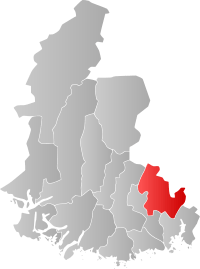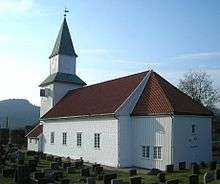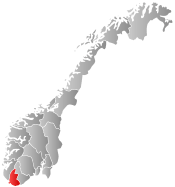Vennesla
| Vennesla kommune | |||
|---|---|---|---|
| Municipality | |||
|
Setesdal Line railway museum in Vennesla municipality | |||
| |||
 Vennesla within Vest-Agder | |||
| Coordinates: 58°18′38″N 7°51′25″E / 58.31056°N 7.85694°ECoordinates: 58°18′38″N 7°51′25″E / 58.31056°N 7.85694°E | |||
| Country | Norway | ||
| County | Vest-Agder | ||
| District | Sørlandet | ||
| Administrative centre | Vennesla | ||
| Government | |||
| • Mayor (2003) | Torhild Bransdal (KrF) | ||
| Area | |||
| • Total | 384 km2 (148 sq mi) | ||
| • Land | 362 km2 (140 sq mi) | ||
| Area rank | 244 in Norway | ||
| Population (2013) | |||
| • Total | 13,986 | ||
| • Rank | 83 in Norway | ||
| • Density | 36/km2 (90/sq mi) | ||
| • Change (10 years) | 5.1 % | ||
| Demonym(s) | Venndøl[1] | ||
| Time zone | CET (UTC+1) | ||
| • Summer (DST) | CEST (UTC+2) | ||
| ISO 3166 code | NO-1014 | ||
| Official language form | Neutral | ||
| Website |
www | ||
|
| |||
Vennesla is a municipality in Vest-Agder county, Norway. Vennesla was separated from Øvrebø in 1861. Øvrebø and Hægeland were merged with Vennesla again on January 1, 1964. Vennesla lies about 17 kilometres (11 mi) north of Kristiansand and has the third largest population in the county.
General information
Name
The municipality (originally the parish) is named after the old Vennesla farm (Old Norse Vendilslá), since the first church was built there. The first element is the genitive case of vendill which means "small twig" (maybe used as a name of an arm of Venneslafjorden) and the last element is lá which means "swamp".
Coat-of-arms
The coat-of-arms is from modern times. They were granted on 15 May 1971. The wavy bend in the arms symbolises the Otra river, which runs through the municipality. The trees symbolize forestry and the cogwheels symbolize industry.[2]
Geography
Vennesla is situated in the Vest-Agder county, Norway, around 17 kilometres (11 mi) north of Kristiansand. The neighboring municipalities are Marnardal and Songdalen in the west, in the east Birkenes and Iveland, in the northeast Evje og Hornnes, and in the south Kristiansand.
Economy
Vennesla has mainly been considered an industrial small town, with Hunsfos Fabrikker AS, a paper mill, as the cornerstone of the community. During recent decades, however, the number of employees has drastically declined from around 1,200 in the 1970s, to 200 in 2005 and 120 in 2007.In 2010 there is 135 employees at the paper mill. In 2011 Hunsfos Fabrikker AS will celebrate their 125 years as a paper mill. www.hunsfos.com
Vikeland Hovedgård

Vikeland Hovedgård is a manor house located by the Otra River. Vigeland Manor was completed in 1847. The building was constructed of wood in both Empire and Swiss style. It was built as part of Vigeland Brug, then one of the largest sawmills in the area. Vigeland Manor was built by Caspar Wild who bought the farm and adjacent sawmill in 1833. In 1894 the farm was sold to John Clarke Hawkshaw whose family retained the manor until around 1960. The current annex was built around 1900. During the 1980s, there was restoration with the main building subsequently used as lodging, corporate and meeting facilities. [3]
The manor house has been said to be haunted by a ghost known as "the Blue Lady" (den Blå Dama). Mari was a farm worker who fell in love with the owner's son. They were not allowed to marry, so it is said Mari committed suicide in the "blue room", hence the title "the Blue Lady".[4]

Vennesla Church
Vennesla Church (Vennesla Kirke) serves Vennesla parish in Otredal deanery (Otredal prosti). The church was completed in 1829 and consecrated the following year. The church was built of stone and brick, while the west tower with side buildings are wooden. The church replaced a church from the first half of the 1600s. The tower was made higher in 1886, and the interior was restored in 1925.[5] [6]
Vindbjart Football Club
The football club of Vennesla is Vindbjart FK, founded in 1896. Vindbjart is currently playing in the Norwegian Second Division and the stadium is Moseidmoen gress.
People from Vennesla
- Børre Knudsen (priest and anti abortion activist; 1937—2014)[7]
Twin Towns - Sister Cities
See also
References
- ↑ "Navn på steder og personer: Innbyggjarnamn" (in Norwegian). Språkrådet. Retrieved 2015-12-01.
- ↑ Norske Kommunevåpen (1990). "Nye kommunevåbener i Norden". Retrieved 27 September 2008.
- ↑ "Vigeland hovedgård (Vigelands verk)". Kulturminnesøk. Retrieved February 1, 2016.
- ↑ "Historien til Vigeland Hovedgård". Vigeland Hovedgård. Retrieved February 1, 2016.
- ↑ "Vennesla kirke". Lokalhistoriewik. Retrieved February 1, 2016.
- ↑ "Otredal prosti". Lokalhistoriewik. Retrieved February 1, 2016.
- ↑ Børre Knudsen er død
External links
-
 Media related to Vennesla at Wikimedia Commons
Media related to Vennesla at Wikimedia Commons -
 The dictionary definition of Vennesla at Wiktionary
The dictionary definition of Vennesla at Wiktionary - Municipal fact sheet from Statistics Norway
-
 Vest-Agder travel guide from Wikivoyage
Vest-Agder travel guide from Wikivoyage - Welcome to Vennesla - Tourist information
- Vigeland Hovedgård


